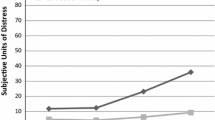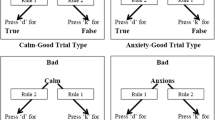Cognitive approaches to social anxiety focus on a person's tendency to make biased judgments for threat-relevant stimuli. This notion was tested relative to whether men's adherence to a toughness male role norm moderates the relation between social anxiety and biased judgments for negative interpersonal events. For negative interpersonal events not involving male role norms, results indicated that only social anxiety was related to probability estimates, while for cost estimates there was a unique association for social anxiety and a significant social anxiety by toughness interaction such that men who were high in both made greater cost estimates. For events involving explicit male role norms, social anxiety and toughness evidenced unique relationships with probability estimates. For cost estimates, in addition to unique associations for social anxiety and toughness, there was a significant interaction, which showed that men high in both characteristics gave the highest cost ratings.


Similar content being viewed by others
REFERENCES
Arkin, R. M., Lake, E. A., & Baumgardner, A. B. (1986). Shyness and self-presentation. In W. H. Jones, J. M. Cheek, & S. R. Briggs (Eds.), Shyness: Perspectives on research and treatment (pp. 189–203). New York: Plenum.
Baldwin, M. W., & Ferguson, P. (2001). Relational schemas: The activation of interpersonal knowledge structures in social anxiety. In W. R. Crozier & L. E. Alden (Eds.), International handbook of social anxiety: Concepts, research, and intervention relating to self and shyness (pp. 235–257). Sussex, England: Wiley.
Baldwin, M. W., & Regehr, C. (1998). Assimilation/contrast effects in priming of evaluative expectations. Unpublished data, University of Winnipeg, Canada.
Brannon, R. (1976). The male sex role: Our culture's blueprint for manhood and what it's done for us lately. In D. David & R. Brannon (Eds.), The forty-nine percent majority: The male sex role (pp. 1–48). Reading, MA: Addison-Wesley.
Brannon, R., & Juni, S. (1984). A scale for measuring attitudes to masculinity. Psychological Document, 14(6), (Ms. 2012).
Bruch, M. A. (2002). Shyness and toughness: Unique and moderated relations with men's emotional expression. Journal of Counseling Psychology, 49, 28–34.
Bruch, M. A., Berko, E., & Haase, R. F. (1998). Shyness, masculine ideology, physical attractiveness, and emotional inexpressiveness: Testing a mediational model of men's interpersonal competence. Journal of Counseling Psychology, 45, 84–97.
Bruch, M. A., Gorsky, J. M., Collins, T. M., & Berger, P. A. (1989). Shyness and sociability reexamined: A multicomponent analysis. Journal of Personality and Social Psychology, 57, 904–915.
Butler, G., & Mathews, A. (1983). Cognitive processes in anxiety. Advances in Behaviour Research and Therapy, 5, 51–62.
Cheek, J. M., & Melchoir, L. A. (1990). Shyness, self-esteem, and self-consciousness. In H. Leitenberg (Ed.), Handbook of social and evaluative anxiety (pp. 47–82). New York: Plenum.
Clark, D. M. (2001). A cognitive perspective on social phobia. In W. R. Crozier & L. E. Alden (Eds.), International handbook of social anxiety: Concepts, research and intervention relating to the self and shyness (pp. 405–429). Sussex, England: Wiley.
Clark, D. M., & Wells, A. (1995). A cognitive model of social phobia. In R. G. Heimberg, M. R. Liebowitz, D. A. Hope, & F. R. Schneier (Eds), Social phobia: Diagnosis, assessment, and treatment (pp. 69–93). New York: Guilford.
Cohen, J., Cohen, P., West, S., & Akin, L. (2003). Applied multiple regression/correlation: Regression analyses for the behavioral sciences. Mahwah, NJ: Erlbaum.
Crozier, W. R., & Alden, L. E. (2001). The social nature of social anxiety. In W. R. Crozier & L. E. Alden (Eds.), International handbook of social anxiety: Concepts, research, and interventions relating to self and shyness (pp. 1–20). Sussex, England: Wiley.
David, D., & Brannon, R. (Eds.). (1976). The forty nine percent solution: The male sex role. Reading, MA: Addison-Wesley.
Fisher, A. R., Tokar, D. M., Good, G. E., & Snell, A. F. (1998). More on the structure of male role norms. Psychology of Women Quarterly, 22, 135–155.
Foa, E. B., Franklin, M. E., Perry, K. J., & Herbert, J. D. (1996). Cognitive bias in generalized social phobia. Journal of Abnormal Psychology, 105, 433–439.
Foa, E. B., & Kozak, M. J. (1985). Treatment of anxiety disorders: Implications for psychopathology. In A. H. Tuma & J. D. Maser (Eds.), Anxiety and the anxiety disorders, (pp. 421–452). Hillsdale, NJ: Erlbaum.
Foa, E. B., & Kozak, M. J. (1986). Emotional processing of fear: Exposure to corrective information. Psychological Bulletin, 99, 20–35.
Garcia, S., Stinson, L., Ickes, W., Bissonnette, V., & Briggs, S. R. (1991). Shyness and physical attractiveness in mixed-sex dyads. Journal of Personality and Social Psychology, 61, 35–49.
Heimberg, R. G., & Juster, H. R. (1996). Cognitive-behavioral treatments: Literature review. In R. G. Heimberg, M. R. Liebowitz, D. A. Hope, & F. R. Schneier (Eds.), Social phobia: Diagnosis, assessment, and treatment (pp. 261–309). New York: Guilford.
Hewitt, P. L., & Flett, G. L. (1991). Perfectionism in the self and social contexts: Conceptualization, assessment, and association with psychopathology. Journal of Personality and Social Psychology, 60, 456–470.
Hofmann, S. G. (2004). Cognitive mediation of treatment change in social phobia. Journal of Consulting and Clinical Psychology, 72, 392–399.
Hopko, D. R., Stowell, J., Jones, W. H., & Armento, M. E. A. (2005). Psychometric properties of the Revised Cheek and Buss Shyness Scale. Journal of Personality Assessment, 84, 185–192.
Kimmel, M. S. (1987). Rethinking “masculinity”! New directions in research. In M. S. Kimmel (Ed.), Changing men: New directions in research on men and masculinity (pp. 9–24). Newbury Park, CA: Sage.
Mahalik, J. R. (1999). Incorporating a gender role strain perspective in assessing and treating men's cognitive distortions. Professional Psychology: Research and Practice, 30, 333–340.
Mattick, R. P., & Clark, J. C. (1998). Development and validation of measures of social phobia, scrutiny fear, and social interaction anxiety. Behaviour Research and Therapy, 36, 455–470.
McCelland, G. H., & Judd, C. M. (1993). Statistical difficulties of interactions and moderator effects. Psychological Bulletin, 114, 376–390.
Meleshko, K. G. A., & Alden, L. E. (1993). Anxiety and self-disclosure: Toward a motivational model. Journal of Personality and Social Psychology, 64, 1000–1009.
Mills, R. S. L., & Rubin, K. H. (1993). Socialization factors in the development of social withdrawal. In K. H. Rubin & J. B. Asendorpf (Eds.), Social withdrawal, inhibition, and shyness in childhood (pp. 117–148). Hillsdale, NJ: Erlbaum.
O’Neil, J. M., Good, G. E., & Holmes, S. (1995). Fifteen years of research on men's gender role conflict: New paradigms for empirical research. In R. Levent & W. Pollack (Eds.), Foundations for a new psychology of men (pp. 164–206). New York: Basic Books.
Pleck, J. H. (1981). The myth of masculinity. Cambridge, MA: MIT Press.
Pleck, J. H. (1995). The gender role strain paradigm. An update. In R. F. Levant & W. S. Pollack (Eds.), The new psychology of men (pp. 11–32). New York: Basic Books.
Rheingold, A. A., Herbert, J. D., & Franklin, M. E. (2003). Cognitive bias in adolescents with social anxiety disorder. Cognitive Therapy and Research, 27, 639–655.
Sinn, J. S. (1997). The predictive and discriminant validity of masculine ideology. Journal of Research in Personality, 31, 117–135.
Spence, S. H., Donovan, C., & Brechman-Toussaint, M. (1999). Social skills, social outcomes, and cognitive features of childhood social phobia. Journal of Abnormal Psychology, 108, 211–221.
Thompson, E. H., & Pleck, J. H. (1986). The structure of male role norms. American Behavioral Scientist, 29, 531–543.
Thompson, E. H., Pleck, J. H., & Ferrera, D. L. (1993). Men and masculinities: Scales for masculinity ideology and masculinity-related constructs. Sex Roles, 27, 573–607.
Watson, D., & Friend, R. (1969). Measurement of social-evaluative anxiety. Journal of Consulting and Clinical Psychology, 33, 448–457.
Wolfe, R. N., Lennox, R. D., & Cutler, B. L. (1986). Getting along and getting ahead: Empirical support for a theory of protective and acquisitive self-presentation. Journal of Personality and Social Psychology, 50, 356–361.
ACKNOWLEDGMENTS
The author expresses appreciation to Eric Deemer and Shaden Sousou for their assistance in conducting this research.
Author information
Authors and Affiliations
Corresponding author
Rights and permissions
About this article
Cite this article
Bruch, M.A. Cognitive Bias in Men's Processing of Negative Social Information: The Role of Social Anxiety, Toughness as a Masculine Role Norm, and Their Interaction. Cogn Ther Res 31, 273–289 (2007). https://doi.org/10.1007/s10608-006-9001-5
Published:
Issue Date:
DOI: https://doi.org/10.1007/s10608-006-9001-5




